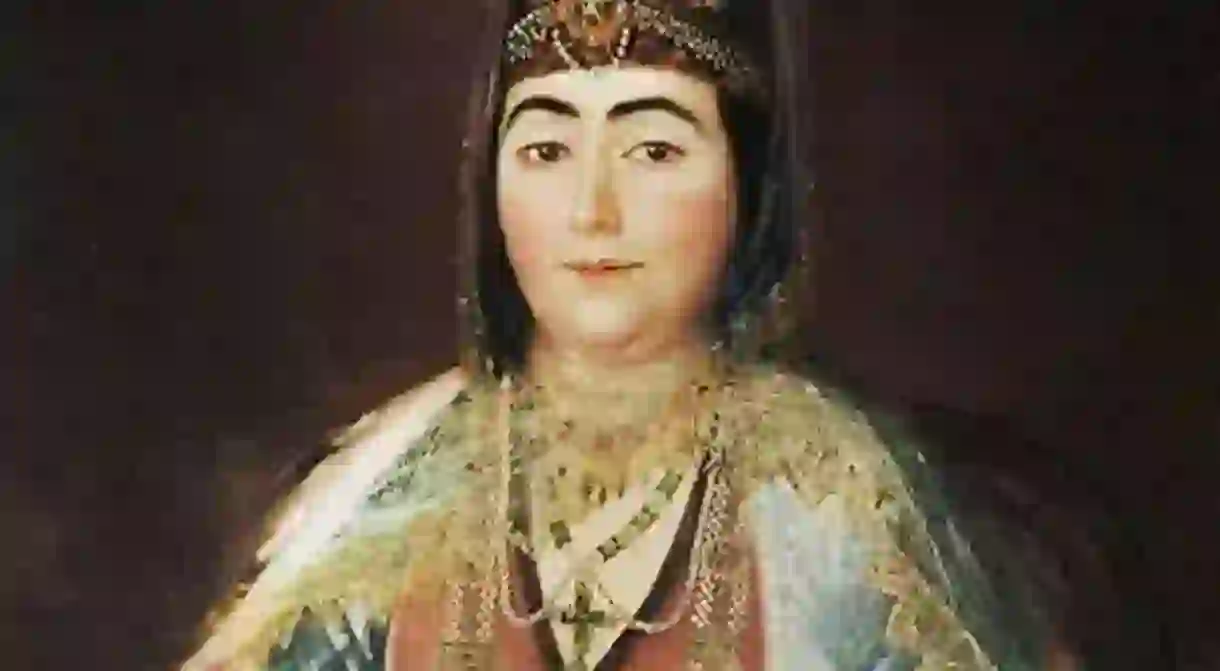The 7 Most Badass Women in Georgian History

Georgian history lacks stories about women’s roles in politics or diplomacy. There are rare sources that talk about the deeds of the queens or other important female figures during the development of the country. However, there are several women who were dramatically important to Georgia and its history. Let’s find out about them.
Medea
Georgia has long been associated with the myth of Jason and the Argonauts, and in Greek mythology Medea was the youngest daughter of the King Aieti of Colchis, who fell in love with Jason – the Greek hero who came to Colchis for the famed Golden Fleece. With the help of Medea, Jason was able to steal the item and fled to Greece. King Aieti not only lost the most important treasure of the country, but also his reign.
Medea is associated with curing diseases and it is believed that she created various types of psychedelic, healing, and deadly oils. She cultivated medicinal plants and studied their properties, the use of poisons, and searched for methods of rejuvenation and life extension.
King Tamar
King Tamar, as locals called her, was the most powerful queen of the 12th century and the granddaughter of David Aghmashenebeli, or ‘the Builder’ in English. Being the only daughter of George III, she was only 18 years old when her father crowned her as a co-ruler of the country. After six years, upon the death of the king, she became the first female king of Georgia. She was an outstanding ruler, who continued the reforms of her grandfather and managed to flourish and extend the territories of the country as well as support the development of Georgian culture.

Ketevan Tsamebuli
At the beginning of the 17th century, the Kartli and Kakheti regions were under the rule of Iran. The rulers of Kakheti showed their loyalty to the shah (the former name for Iranian monarchs) while secretly preparing a rebellion, led by Queen Ketevan. When her husband, David, died, Queen asked Shah-Abas to make Teimuraz II the king of Kakheti. Her request was approved, but due to the fact that Teimuraz was only 16 years old, the region was governed by Ketevan. However, Shah had other ideas regarding Kakheti. He wanted to morally break Georgians and demanded the Queen accept Islam as her main religion. Queen Ketevan had a prominent influence and good connections, and the shah believed that if she refused Christianity and accepted Islam, it would have been his great victory. Unfortunately, Ketevan refused many times. In the end, on September 12 1624, she was publicly tortured with warm chains and executed in Shiraz.
Her nickname ‘Tsamebuli’ means ‘tortured’ in Georgian.
Queen Darejan
Queen Darejan was the third wife of King Erekle II and she was against her husband’s close relations with Imperial Russia from the outset. The queen started to actively interfere with royal affairs and as early as 1770, Darejan saw the real face of Russian diplomacy and didn’t believe in Russia’s supposed help and protection. Not only Erekle’s children, but many famous and influential people took the queen’s side, leading to the first anti-Russian movement inside the royal family. Unfortunately, Darejan and her supporters didn’t succeed and in 1783 Erekle II signed the Treaty of Giorgievsk according to which Kartli-Kakheti region became the protectorate of Russia and guaranteed its territorial integrity and the continuation of its reigning Bagrationi dynasty.
In 1795, Georgia was invaded by Agha Mohammad Khan, who destroyed the country and took several prisoners. Russian help never came. In 1801 the Russian Emperor Alexander I signed a manifesto to abolish the Kartl-Kakheti kingdom. Georgia had lost its independence and became part of the Russian Empire. The establishment of the Russian regime was followed by political demonstrations in Kakheti in 1802, and the Mtiuleti rebellion in 1804.
With the hope of saving the kingdom, everyone turned to Darejan, who demanded a restoration of the throne and annulment of the manifest. The Russian Empire decided to exiled Queen Darejan to Russia and abolish the Bagrationi Dynasty. Darejan was the last queen of Georgia.

Maro Makashvili
Mariam (Maro) Makashvili, born in 1902 in the family of a nobleman was a nurse. Her father, Konstantine Makashvili was a poet and one of the founders of the Georgian Writers’ Union; while her mother, Tamar Gabashvili, was the daughter of Ekaterine Gabashvili, a Georgian writer.
In 1921, when the Red Army entered Georgian territory, the 19-year-old Maro volunteered as a nurse in the Red Cross and joined the sanitarian squad. Unfortunately, four days later after the invasion, on February 19, she was wounded by a grenade and died on February 20.
Nino Jorjadze
Three months after Austria-Hungary declared war on Serbia in 1914 and began the First World War, Nino Jorjadze, a 30-year-old Georgian citizen became a member of the Red Cross and headed to the battlefield. She was a nurse who not only helped the wounded soldiers but depicted the stories of the war and gave Georgia unprecedented photographic material of the battlefield.
Nazi Shamanauri
Nazi Shamanauri was a journalist during the 1970s who published letters where she boldly disclosed the faulty rule and events that were happening in the whole country. Her last letter ‘Village Life’ was published in 1974 and afterwards, the publishing houses refused to publish her writings.
In 1982, during a celebratory event in Chargali, she delivered a speech where she exposed the criminal acts of the officials of Dusheti district, as well as the disastrous situation of Georgia. She and her mother were immediately detained by militia officers. The Dusheti District Court sentenced her and her mother to compulsory treatment in Tbilisi Psychiatric Hospital, where Nazi started a hunger strike which lasted for 70 days. Nevertheless, she was still tortured with insulin shocks and neuroleptic injections, which severely damaged her health condition. In 1983, Nazi was severely beaten by the facility staff and transferred to hospital where she died.













